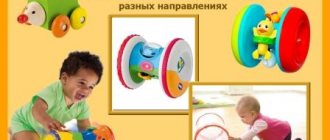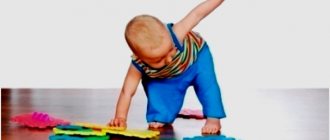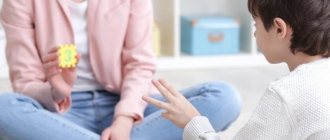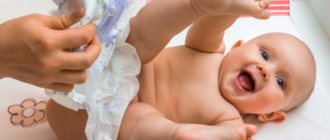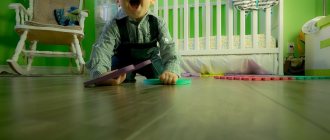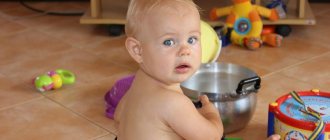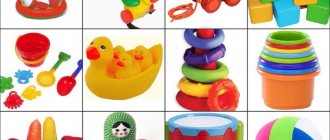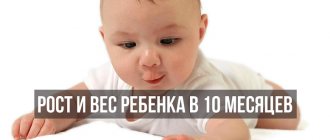Time flies very quickly in the first year of a baby's life. By the age of one year, a child, as a rule, already confidently walks on his own legs, can pick up small objects, understands the speech of mom and dad well, plays with pleasure and, of course, observes the world around him with great curiosity. The main task of parents during this period is to direct his development in the right direction. Experts at the Karkusha Early Development Center tell you how to do this correctly.
Intellectual development
Since the child is still content with the role of observer, games should be aimed at actively receiving visual, auditory and tactile impressions, understanding them, remembering and applying them.
- Make thematic albums “Vegetables”, “Fruits”, “Animals”, “Clothes” and others by pasting corresponding pictures into ordinary drawing pads. Let's look at it for the baby, naming what is depicted.
- It is also useful for a child to look at a family album, which contains high-quality photographs of close relatives whom he knows well.
- If it's a sunny day, show your child that objects and people cast shadows, play with a mirror, try to step on it or catch a sunbeam.
- Play different types of music for your child, learn how different musical instruments sound, this contributes to the development of auditory perception.
- Games with a sorter and geometric shapes will form a child’s understanding of different sizes and shapes.
- Build your child's first library of books with thick cardboard pages and colorful drawings. Of course, he will not learn to read right away, but he will love to study with a book, this is the first step to reading.
- Encourage your child to socialize with other children and adults.
- When playing with your baby, give him freedom of action, even if from your point of view he is doing something wrong.
- Buy a Lego-type construction set with large parts, cubes, toys without musical and other entertainment elements. Playing with them forces you to use your imagination and come up with a scenario on your own.
- Gradually teach your child to be independent, allow him to help you by giving feasible instructions.
Limit TV viewing and tablet activities. Because of “ready-made” entertainment, the child becomes a passive observer, and not an active participant in the game process, as it should be.
General characteristics of child development by one year
First of all, they pay attention to health. Physical condition characterizes the weight and height of the child. By the year he grows by about 25 cm to 75-78 cm. His psychomotor skills and reflexes are actively developing. He tries to stand on his feet and walk, holding on to surrounding objects.
Interest in all manifestations of life is expressed by joyful emotions, including in relation to people, and strives to learn new objects and phenomena.
A 12-month-old child stands independently, holding onto a support
He distinguishes between friends and foes well. Knows his name well. Curiosity is the motivating force for movement, so you need to keep an eye on the child. His first steps are accompanied by countless falls, so he needs your support. Changes positions: being on all fours, easily moves in all directions and changes direction.
Speech development
Normally, the active vocabulary of a one-year-old child consists of 10-12 one-syllable or two-syllable words. One word often means a complete phrase; in addition, the baby complements the words with gestures and facial expressions. This age is characterized by the formation and improvement of speech skills, but they will not appear on their own. Speech development requires maximum parental attention. So what should you do?
- Constantly talk to your baby and make sure your speech is correct, because you are almost the only example. One-year-old children understand well what their parents tell them.
- When looking at illustrations in books, describe them out loud, ask your child simple questions, for example, “where is the cat’s tail?”
- Read aloud short fairy tales, poems, nursery rhymes. Play nursery rhymes while your child is awake.
- Sing vowel sounds and syllables with your baby, gradually complicating the “song.”
- Tell your baby about the world around him, about everything you see while walking or at home: what it’s called, why it’s needed, what it does, etc. Speak out your actions, describe objects.
- Discuss the plot pictures, explain to your child how to build a logical chain. Of course, you will do most of the talking, but the child will listen to you and remember the speech pattern.
Be sure to do exercises to develop articulation so that the muscles involved in pronouncing sounds get used to new movements. Don't neglect finger exercises and massage. Brain centers associated with nerve endings in the palm and pads and responsible for gross and fine motor skills are located next to the centers of speech, logical thinking, and memory.
Fine motor skills
The importance of developed fine motor skills is obvious. Teachers at the Karkusha Early Development Center recommend performing the following games and exercises:
- Modeling from salt dough, plasticine, clay. Start with a ball, then flatten it into a flat cake and roll it into a sausage, etc.
- Drawing with regular or finger paints, pencils. First, you will have to help your baby, support his hand, show him how to make strokes and draw lines.
- Creating compositions from plasticine, sticks, pebbles, buttons, shells, etc.
- Lacing, winding bright woolen threads into a ball.
- Busy board. You can buy it in a store or make it at home: screw a switch, a latch, an abacus made of large beads, a socket with an attached plug, patches with Velcro, buttons, etc. onto a sheet of plywood.
- Games with insert frames and sorter.
- Get a sensory box where you need to put objects of different colors, shapes, sizes, weights, and surfaces.
- Games with colored rice, beans, pasta: pouring, laying out patterns, “drawing” pictures.
Various experiments with sand and water give excellent results. They have a constant effect on the receptors and give the child a rich tactile experience. Be sure to take him to the sandbox, play while swimming in the bathtub and children's pool, buy him floating toys, molds, a sieve, bucket, scoop or ladle so that he can play with water and sand.
Developmental activities with a one-year-old baby should be based on the following principles:
- Regularity. Exercise daily, preferably at the same time. Only in this case the exercises will be effective.
- Diversity. Alternate exercises aimed at physical,
cognitive, sensory, motor, speech, mental development.
- A gaming form, since play is the leading activity of a small child.
- Short duration. A day is enough to spend 10-15 minutes on each exercise.
- Help. You will have to constantly help your baby, because he will have to perform many actions for the first time.
- Comfort. Practice in a warm, ventilated room, make sure that the child is wearing a clean diaper, feels well, is not hungry or thirsty, and has slept well.
If the child is capricious, then it is better to postpone the lesson. If you cannot regularly tutor your child yourself, sign up for classes at an early development center. Studying in a mini-group under the guidance of an experienced teacher, the child quickly socializes and masters the necessary skills.
Publication date: 09/10/2018. Last modified: 01/13/2020.
Food recommendations for children aged 1 to 3 years
Dairy products
At the age of 1.5 to 3 years, a child on average needs:
- 5 g cheese;
- 25–50 g cottage cheese (fat content 5–11%);
- 5–10 g of cream or sour cream (10–20%);
- 500–550 ml of milk and kefir (3.2–4%).
At the age of 1 year, a child needs 100 g of meat per day, from 1.5 years old - 120 g. It is recommended to prepare dishes from beef, veal, turkey, rabbit and lamb. Offal is tasty and healthy: liver, tongue, heart. Dishes made from them are faster and easier to digest and are rich in protein and fat-soluble vitamins. But! If a child has problems with the kidneys, gall bladder or a tendency to allergies, the introduction of offal into the diet at this stage is not recommended.
Meat can be prepared in the form of steamed and oven cutlets, stews and fried minced meat.
But it is better not to introduce your child to sausages and sausages, since the quality of these products is most often questionable.
Egg
Children should be given 1 egg no more than 2 times a week, exclusively in hard-boiled form or as a steam omelet.
If a child is not allergic to seafood, it is recommended to supplement his diet with dishes made from sea and river fish. You should avoid fatty and delicacy varieties, smoked and canned fish, as well as caviar. The daily intake of fish is up to 30–40 g.
In the children's menu, fish can be presented boiled and stewed, in the form of cutlets and meatballs. Of course, it must be pitted before cooking.
Vegetables
The children's menu should include potatoes, carrots, cabbage, zucchini, pumpkin, beets, turnips, peas, beans, and beans. It is not advisable to give tomatoes before 3 years of age, as they irritate the gallbladder and often cause allergies. At the age of 1.5 to 3 years, children are recommended to consume up to 100–120 g of potatoes daily, as well as 150–200 g of other vegetables in the form of soups, salads, and side dishes.
From the age of 1.5 years, a child should be fed fresh herbs: parsley, spinach, lettuce and green onions, used to season soups, salads and main courses.
Fruits and berries
Children aged 1 to 3 years should eat 100–200 g of fruits and 10–20 g of berries per day. These can be apples, pears, plums, bananas, cherries (pitted), black currants, gooseberries, lingonberries, cranberries, chokeberries and sea buckthorn.
From 1 year to 1.5 years, a child should be offered clarified juices, and after 1.5 years - juices with pulp (up to 100-150 ml per day after meals).
If your baby tries a previously unfamiliar juice, you should start with 1–2 teaspoons in the first half of the day to see the body’s reaction.
Cereals
It is recommended to prepare porridge from oatmeal, buckwheat, barley, millet, wheat, corn and pearl barley. The daily intake of cereals for children aged 1.5 to 3 years is 15–20 g.
Pasta
At the age of 1.5 years, children can already eat noodles and vermicelli in the form of soups and side dishes. However, pasta is rich in carbohydrates, so you should not overuse them in your children's diet. The daily intake of noodles and vermicelli for children from 1.5 to 3 years old is no more than 50 g.
Sugar
A child aged 1.5 to 3 years can consume up to 30–40 g of sugar per day. This amount is already included in baked goods, juices, fruits and sweets. Abuse of sugar reduces appetite, negatively affects metabolic processes and leads to excess weight.
Sweets
At the age of 1.5 to 3 years, children can be treated to marshmallows, marmalade, fruit caramel, jam and marshmallows.
Chocolate
You should wait with chocolate and chocolate candies until the age of 3, as they provoke excitability of the nervous system and can cause allergic reactions, load the pancreas and irritate the gallbladder.
Liquid and semi-liquid food should be replaced with denser ones in order to teach the child to chew it. To do this, introduce boiled porridge, stewed vegetables, vegetable and cereal casseroles into your baby’s diet.
1 year old baby routine
Children's doctors believe that after a year the rhythm of life should not change dramatically. More important is the concept of regime itself. When a child is 1 year old, it will be easier for him and his parents if getting up, breakfast, sleep and other key moments of the day occur at the same time every day. The daily routine of a 1 year old child will be something like this:
- Wake up at 7-7.30.
- Next, mother and baby do gymnastics and carry out morning hygiene procedures.
- At 8 am it is time for breakfast.
- After this comes a period of wakefulness and games.
- At 10 am you can put your baby to bed for the first time.
- The baby sleeps until about 12, then has lunch and at 12.30 it’s time for a walk and active pastime.
- At 3:30 p.m., the baby is ready to take a second nap. This sleep can last up to one and a half hours.
- At 16.30 there is afternoon tea.
- At 17.00 you can go outside for the second time.
- 19.00 – dinner time, then evening swimming, dinner and at half past eight – sleep.
How much should a 1 year old baby sleep?
A 1 year old child's daily sleep should be approximately 14-16 hours. Of these, 11-12 hours are night sleep, and the remaining hours are daytime sleep. But some babies grow up earlier and no longer want to sleep twice. This is a signal to parents that the little one has already grown up, and this regime does not suit him. In this case, it’s time to rebuild your routine and switch to one nap, which can last up to 3 hours. It is important to remember that such a decision should come when the baby himself is ready for it.
Diet for a 1 year old child
Adults are interested in what to feed a 1-year-old child? How many times should a child eat and how much should he eat at 1 year old? Answers to these and other questions are presented below:
- The number of meals at this age should be 4-5. If the child is 1 year old and the mother is still lactating, this is good, but in addition to mother’s milk, the baby should already receive useful substances from foods.
- So, in the morning, you can still give porridge. Its volume is 150-200 ml. As an option, you can also offer a steam omelet. It is better to choose white bread. Its amount per day should be up to 50 g.
- For lunch, it is advisable to give up to 200 ml of the first course with 50 g of boiled lean meat.
- You can gradually expand the menu by carefully introducing offal and fish.
- For an afternoon snack, instead of baby cottage cheese, you can already prepare cottage cheese with sour cream, curd soufflé. Every other day you can give your little one biscuits with fruit puree.
- A one-year-old baby's dinner should consist of milk or dairy-free porridges, for example, with vegetables. Sometimes potato dishes are acceptable, but you shouldn’t get carried away with them.
- Before going to bed, you can offer baby kefir.
- In addition to food, the child must receive liquid. Its total volume from 12 to 36 months is 100 ml/kg. For drinking, you can offer clean water, compotes of fresh berries or dried fruits. At the same time, it is advisable not to sugar them. Little by little you can give natural juices diluted with boiled water.
- It is important to follow a diet. So, over time, the child will produce the enzymes necessary for digestion at the right time. The main thing is that when choosing what to feed a child of 1 year, adults should understand that his diet should not contain cakes, smoked meats, sausages and other unhealthy foods.
Healthy eating is a habit formed from childhood
The formation of a nutritional culture occurs at an early age. Therefore, it is important for parents to promptly teach their baby what is tasty and healthy. And you can prepare nutritious and dietary dishes according to our recipes for children - they already contain all the useful information on calorie content and the content of micro- and macroelements, so that it is convenient for mothers and fathers to create a menu suitable for the baby for every day.
At the age of 1 to 3 years, a child needs:
- proteins – 50–60 g, including 70–75% animal proteins;
- fats – 50–60 g, including about 10 g of vegetable fats;
- carbohydrates – 220 g.
Olesya Butuzova, pediatrician: “Important advice is the right example. If you want your baby to get used to proper nutrition from childhood, eat healthy food. You shouldn’t demand that your child love boiled broccoli if you eat smoked sausage in front of him. Healthy eating is a general rule for the whole family!”
Author: Elena Nersesyan-Brytkova
The first year of a baby's life
very responsible and joyful for parents. During this year, the child turns from a helpless little lump into an independent person, capable of not only speaking and standing on his feet, but also having his own preferences, character and taste.
Every new baby
brings parents pride and great joy for their treasure. The pace of development of babies in the first year of life depends on many factors, so it would be a mistake on the part of parents to expect strict compliance in the child’s development to certain standards. However, there are indicative standards by which one can judge the development of a child who is 1 year old.
These are the norms
that a one-year-old child should be able to do: 1.
At the end of the first year of life, the baby
masters independent walking. Some children, mostly girls, are already beginning to walk without support at this time, while others are only taking their first steps. Most children at this age, having mastered walking, prefer to crawl rather than walk. After all, “walking on four” is much more comfortable and reliable than swinging on two legs.
Don't rush your baby
, let him gain confidence. Parents of children who are only crawling at the age of 1 year do not need to diligently force the baby to stand on his feet, but rather praise him and support him for mastering new skills in movement. Having gained confidence, under the approving smiles of his parents, the baby will very soon stand on his own legs and begin to walk.
2. At the age of 1 year baby
tries to imitate the sounds he hears, his vocabulary usually reaches 10 words. Most often these words are: “Ma-ma”, “Pa-pa”, “Ba-ba”, “Yum-yum” and others. He already understands his parents’ demands, knows all family members by name, although he does not name them. The baby’s passive vocabulary is enormous; he recognizes family members in photographs, pictures of animals, and shows his nose, mouth, eyes and other parts of the body at the request of his parents.
Baby
already picks up the intonation of adults and is offended if he is scolded. He knows how to generalize objects, people and animals. For example, if he calls his car “pee-pee,” then when driving a car he also repeats “pee-pee.” A one-year-old baby perceives simple melodies well and feels their rhythm.
In this age
children are very obedient, they gladly fulfill their parents’ requests such as “give”, “pick up”, “put away”, “kiss”, “hug” and so on. He understands well the meaning of the word “impossible.” The baby is able to distinguish primary colors: red, blue, green, black and white. When asked: “Please give me a blue cube,” he finds it among the toys and hands it to an adult.
3. One year old child
actively moves around the room and plays with other people. He carefully examines his toys and surrounding objects, rattles and knocks with them, throws them and crawls after them. He really enjoys putting things in and out of boxes, opening cabinets and closing their doors. He carefully watches the adults and tries to imitate their movements.
If they buy him a new toy
, he hands it to the adults so that they can show how they should play. The one-year-old baby loves to roll toys on wheels, collect blocks and play hide and seek. He already knows how to look for hidden toys, and also always keeps his parents in his field of vision. If he sees that they have gone to another room, he quickly crawls or follows them.
Empty the contents of the drawers
for linen and kitchen cabinets, moving interior items, overturning chairs, pulling everything he can, painting walls and books, tasting objects that come his way - these are the favorite activities of kids of this age. He is happy that he is able to perform the same movements as adults. You can’t scold him for this, much less punish him, because he doesn’t do them out of harm. You just need to keep an eye on a baby who is one year old all the time and patiently teach them to understand what is “bad” and what is “good.”
4. Child aged 1 year
acquires simple self-care skills. He already knows how to drink from a cup, tries to eat with a spoon, reaches out for bread himself, takes pieces of food and brings them to his mouth. He already has 12 teeth: eight of which are incisors, and four are chewing teeth. The diet of children during this period should be varied, rich in vitamins, calcium and phosphorus.
5. One year old child
should already ask to go to the potty. If your baby doesn’t do this yet, then the parents themselves are to blame. It is best to start potty training your baby from the age of six months, and if you missed this time, then start doing it now. A baby who is 1 year old already understands well what his parents require of him and quickly gets used to the potty. But you shouldn’t act rashly and force your baby to sit on the potty for hours; the training process should be gradual, but regular.
All children
develop in different ways, in their own individual ways. Therefore, these norms of child development are indicative. If your child does not yet meet any of the norms described above, this does not mean that he is behind in development. Surely he can do something else that others can’t. The main thing in the development of a child in the first year of life is his health and desire to explore the world around him. The task of parents is to support him and help the baby in this difficult period of life for him.
— We recommend visiting our section with interesting materials on similar topics
"Psychology of Relationships"
The last month of your baby’s first year has arrived. Very soon he will blow out the first candle on his birthday cake. The tiny newborn has turned into a small but independent person.
Physical development of the child
On average, children triple their weight in the first year of life, and the final increase in height is about 25 cm. Thus, by the age of 1 year, the child’s height on average reaches 75 - 76 cm.
The baby can already stand confidently without support, actively crawls, squats, straightens, rises to his feet from any position, climbs onto a chair, bed and goes down to the floor. The child walks well with hand support, and possibly independently. A one-year-old child walks with his legs spread wide apart: his feet are directed to the sides, his legs are bent at both the hip and knee joints, the spine is bent forward in the upper part, and bent backward in other parts. The arms are first extended forward to shorten the distance, then balanced to maintain balance or bent and pressed to the chest for insurance when falling. Further improvement of walking occurs up to primary school age.
Skills and abilities of a one-year-old child
The baby recognizes all his loved ones (including in photographs) and rejoices at their appearance. He is very emotional, actively shows his feelings: kisses, hugs you, or, on the contrary, expresses dissatisfaction in response to a ban or the strict tone of your voice. Reacts to music: dances and “sings along” to the beat. The child enjoys looking at his reflection in the mirror, playing with it and making faces. He also easily imitates the facial expressions of adults.
A year old baby can concentrate on one thing for about 5 minutes. He can, at the request of an adult, bring his toys, and he is able to take several in one hand at once. In addition, the child can put a toy under his arm to free his hands for another.
He already distinguishes well all the primary colors, recognizes and shows animals in pictures. A child can assemble a pyramid of three or four rings, or build a tower of two or three cubes. Plays simple story games.
At this age, children love to pour toys out of the box and put them in it. They also like to give you items and take them back. By the age of one year, the baby has mastered the simplest everyday skills. He bites off and chews pieces of bread and cookies, tries to eat with a spoon, and independently drinks from a bottle, sippy cup, and even a mug. The child can help you wash and dress himself, holding out his arms and legs.
The kid understands the word “impossible”, but does not always obey the prohibition. It is important not to use this word too often, and not to cancel the ban. Otherwise, you risk that the child will not take it seriously.
Infancy
The newborn is a transitional stage.
Adaptation with the help of hereditarily fixed mechanisms - the system of food reflexes (food concentration). Unconditioned reflexes – protective and indicative. By the end of the first month, the first conditioned reflexes appear (the baby begins to respond to the feeding position), but in general they develop later.
Mental life. The brain of a newborn continues to develop, it is not fully formed, therefore mental life is connected mainly with the subcortical centers, as well as with an insufficiently mature cortex. The sensations of a newborn are undifferentiated and inextricably fused with emotions, which made it possible for L.S. Vygotsky speaks of “sensory emotional states or emotionally emphasized states of sensations.”
Important events are the emergence of auditory (2–3 weeks) and visual (3–5 weeks) concentration.
Specific social situation of development - helplessness, biological connection with the mother, dependence on an adult.
At about 1 month - the “revitalization complex” - a violent emotional reaction to the appearance of the mother, including a smile, which means the first social need - the need for communication. This marks a new psychological period. Infancy proper begins.
Infancy
Cognitive development of the child: perception - by 4 months. not just sees, but already looks, actively reacts to what he sees, moves.
Perceives the shape of objects, identifies the contour and their other elements, and is able to navigate many parameters of objects (movements, contrasts, etc.).
React to color.
Spatial perception develops, in particular depth perception.
For development, it is necessary to satisfy his need for new impressions, trying to ensure that the environment around him is not monotonous and uninteresting. The baby has a holistic picture of the world.
Movement and actions. Hand movements directed towards an object and feeling an object appear at about 4 months of life.
At 5 – 6 months, an object is grabbed, which requires complex hand-eye coordination – the first purposeful action. Chains of identical, repeating actions unfold, which J. Piaget called circular reactions.
After 7 months, “correlating” actions occur: putting small objects into large ones, opening and closing the lids of boxes.
After 10 months, the first functional actions appear, but they are not yet objective (imitation of adults).
Perception and action make it possible to judge the initial forms of visual-effective thinking.
The cognitive tasks that the child is able to solve become more complex, first only in terms of perception, then using motor activity.
Memory. Recognition comes first. A 4-month-old baby distinguishes a familiar face from an unfamiliar one.
After 8 months, reproduction appears - restoration of the image in memory.
Emotional development. In the first 3 - 4 months. Various emotional states appear: surprise in response to the unexpected (inhibition of movements, decreased heart rate), anxiety in response to physical discomfort (increased movements, increased heart rate, squinting of the eyes, crying), relaxation when a need is satisfied. After 3–4 months, he smiles at acquaintances, but is somewhat lost at the sight of an unfamiliar adult. At 7–8 months, anxiety when strangers appear increases sharply. Around the same time, between 7 and 11 months, the so-called “fear of separation” appears. By the end of 1 year, he strives not only for emotional contacts, but also for joint actions.
Speech. In the first half of the year, speech hearing is formed. Booming. In the second half of the year - babbling, usually combined with expressive gestures. By the end of 1 year, the child understands 10–20 words spoken by adults, and he himself pronounces one or several of his first words, similar in sound to the words of adult speech. With the appearance of the first words, a new stage in the child’s mental development begins.
